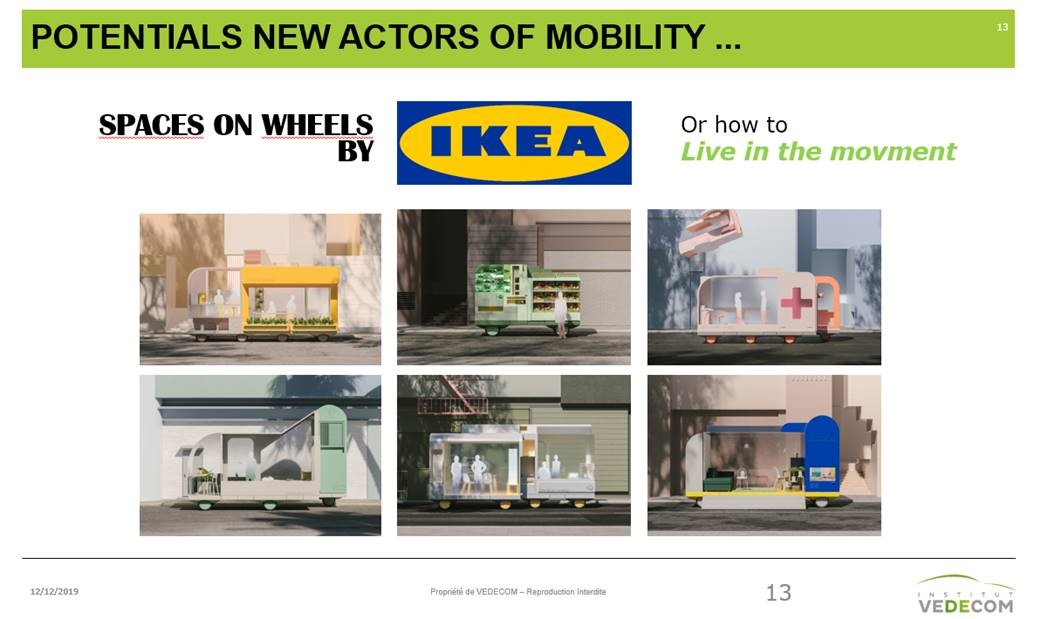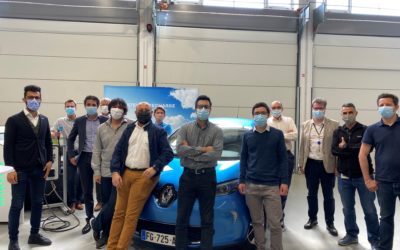Mobile Hyperplaces: mobile activities for new forms of urbanity
Mobile Hyperplaces: mobile activities for new forms of urbanity
An event organised by Le Point and entitled “The City, New Horizons”, took place at the Villa Massena in Nice on Friday 29 November 2019. The objective of the day was to look at the levers and issues involved in the necessary transformation of our urban spaces. How can we create fertile ground to foster the emergence of balanced regions that will be home to multi-cultural, diverse, appealing and environmentally-friendly cities? And how can we overcome the often overused concepts of “sustainable” or “smart” cities? Prestigious speakers such as Jean Nouvel, Jean-Jacques Aillagon and Antoine Picon were invited to share their insights. Mireille Apel-Muller, Director of the City on the Move Institute (IVM), part of VEDECOM, presented the concept of mobile hyperplaces, as developed by the IVM. We look back at her talk, which uses the autonomous vehicle as a catalyst to open new horizons for tomorrow’s mobility.
“Beyond the autonomous vehicle: the challenge of mobile hyperspaces”
The emergence of a new concept was the driving force behind Mireille Apel-Muller’s presentation at the “The City, New Horizons” event. The IVM, an institute whose mission is to examine the more complex societal dimensions of mobility beyond the issue of transport,
came up with mobile hyperplaces, a concept which involves a range of considerations such as social uses and practices, interactions with planning and public spaces and governance. Through the concept of mobile hyperplaces, the IVM has been turning its attention to a third avenue thus far neglected: mobility from vantage point of activities and services. This field of thought has yet to be fully explored, which is ironic since mobile activities, already omnipresent, promise to become an increasingly important part of our lifestyles.
The “Mobile Hyperplaces” project: observing society in order to innovate
In order to make the concept more concrete, the IVM and its international partners went out in search of existing mobile activities. Mobile activity, by its very definition, involves all activities supported by mobility. These activities are nothing new and can be seen throughout human history, from door-to-door sales and travelling fun fairs to mobile war hospitals. They have used all types of vehicles and involve all sectors. In total, the “Mobile Hyperplaces” project has identified more than 600 mobile activities and made a single observation: far from relegating these mobile activities to the past, hyper-connectivity and the digital revolution are driving their increasing diversification. Moreover, we can see the emergence of hybridisations made possible by the combined transformation of the digital realm (facilitated database transport), technological progress (producing one’s own energy) and eco-systemic thinking. Through the provision of activities and services, the mobile hyperplace helps create unexpected forms of urbanity, which are being generated by new interactions between spaces, mobility, connectivity and activity. The vehicle itself sometimes becomes a genuine mobile place of activity, such as with party buses in Buenos Aires and Paris. On other occasions, the mobile activity results from the creation of ephemeral forms of urbanity surrounding it. For instance, a vehicle in Australia used to support homeless populations doubles as a mobile laundromat and open-air cinema, screening films while people wait for their laundry.
New players unite to invent the mobile city of tomorrow
This trend is not the result of isolated cases, but rather a tidal wave of change supported by major industrial companies. This is how Toyota presented its “On-Demand City” project at the Las Vegas Auto Show. The idea: to design an autonomous e-Palette Concept Vehicle that is capable of accommodating a wide range of activities such as hospitals, mobile office space, corner shops, pizzerias and even “fab labs”.
A champion of furniture for small spaces, Ikea has also jumped on board with its SPACE10 research and design lab for mobile and autonomous objects. Everywhere around us we are seeing new players whose ambition is to build the city of tomorrow, which is mobile!
Mobile hyperplaces for the city of tomorrow: issues and challenges
Redefining everyday places in this manner, through vehicles to accommodate mobile activities, is not without its challenges. It’s a challenge for less populated areas, because these kinds of activities, solutions that bring a high quality of service, are conceived with urban metabolisms in mind. It’s also a challenge for the planners who must provide new spaces for such amenities and programme activities that remain under the control of public authorities. It’s a challenge for designers: not only must our objects change, but also the spaces to accommodate them. It creates significant issues for politicians as well. It will be necessary to manage licit and illicit activities, mediate conflicts of use between mobile activities and fixed businesses, control the privatisation of public space and keep spaces from being over-used. There are economic issues too: how do we invent a new generation business models for these small-scale, very agile activities? Last but not least, it’s a societal issue, since we will need to determine how much of our space and time we want to give over to economic activity.

Articles récents :
European 5G-MOBIX Project French site Demonstration and Seminar
5G for connected and automated cooperative mobility: towards greater safety and efficiency 21 April 2022, 9 AM - 6 PM Organisation : VEDECOM, Catapult, AKKA Technologies and VALEO Location: VEDECOM headquarters at mobiLab and Satory tracks, Versailles. 23 bis allée...
E-mobility: a successfull demonstration of the Certificate Trust List for Plug & Charge interoperability
The Certificate Trust List has been demonstrated on the 2nd of June 2021 as a technical solution for ISO 15118 Plug and Charge interoperability. The objective is to simplify the user experience wherever he is and guarantee the interoperability between any vehicle and...
“Machine Learning for the distributed and dynamic management of a fleet of autonomous taxis and shuttles”
Thesis defence of Tatiana BABICHEVA « Machine Learning for the distributed and dynamic management of a fleet of autonomous taxis and shuttles » 10 mars 2021 - 9h30 Online : Zoom Follow this event : [button...



